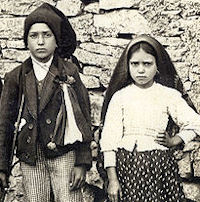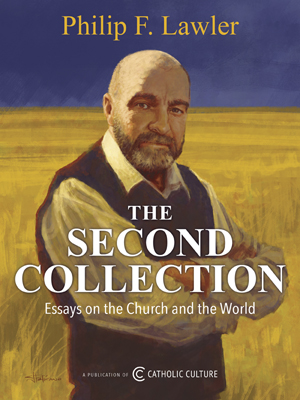Ordinary Time: February 20th
Monday of the Seventh Week of Ordinary Time; Bls. Francisco & Jacinta Marto (Portugal)
Other Commemorations: St. Jacinta Marto (RM)
» Enjoy our Liturgical Seasons series of e-books!
This feast can only be celebrated publicly in Portugal at the moment, but assuming Bl. Francisco and Jacinta Marto are eventually canonized, it will be then be possible to celebrate it universally. It is, however, possible to celebrate in privately in other parts of the world now.
Blessed Francisco & Jacinta Marto
Between May 13 and October 13, 1917, three children, Portuguese shepherds from Aljustrel, received apparitions of Our Lady at Cova da Iria, near Fatima, a city 110 miles north of Lisbon. At that time, Europe was involved in an extremely bloody war. Portugal itself was in political turmoil, having overthrown its monarchy in 1910; the government disbanded religious organizations soon after.
At the first appearance, Mary asked the children to return to that spot on the thirteenth of each month for the next six months. She also asked them to learn to read and write and to pray the rosary “to obtain peace for the world and the end of the war.” They were to pray for sinners and for the conversion of Russia, which had recently overthrown Czar Nicholas II and was soon to fall under communism. Up to 90,000 people gathered for Mary’s final apparition on October 13, 1917.
Less than two years later, Francisco died of influenza in his family home. He was buried in the parish cemetery and then re-buried in the Fatima basilica in 1952. Jacinta died of influenza in Lisbon, offering her suffering for the conversion of sinners, peace in the world and the Holy Father. She was re-buried in the Fatima basilica in 1951. Their cousin, Lucia dos Santos, became a Carmelite nun and was still living when Jacinta and Francisco were beatified in 2000. Sister Lucia died five years later. The shrine of Our Lady of Fatima is visited by up to 20 million people a year.
— Excerpted from Saint of the Day: Lives, Lessons and Feast by Leonard Foley, O.F.M.; revised by Pat McCloskey, O.F.M.
St. Jacinta Marto
Between May 13 and October 13, 1917, three children, Portuguese shepherds from Aljustrel, received apparitions of Our Lady at Cova da Iria, near Fatima, a city 110 miles north of Lisbon. At that time, Europe was involved in an extremely bloody war. Portugal itself was in political turmoil, having overthrown its monarchy in 1910; the government disbanded religious organizations soon after.
At the first appearance, Mary asked the children to return to that spot on the thirteenth of each month for the next six months. She also asked them to learn to read and write and to pray the rosary “to obtain peace for the world and the end of the war.” They were to pray for sinners and for the conversion of Russia, which had recently overthrown Czar Nicholas II and was soon to fall under communism. Up to 90,000 people gathered for Mary’s final apparition on October 13, 1917.
Less than two years later, Francisco died of influenza in his family home. He was buried in the parish cemetery and then re-buried in the Fatima basilica in 1952. Jacinta died of influenza in Lisbon, offering her suffering for the conversion of sinners, peace in the world and the Holy Father. She was re-buried in the Fatima basilica in 1951. Their cousin, Lucia dos Santos, became a Carmelite nun and was still living when Jacinta and Francisco were beatified in 2000. Sister Lucia died five years later. The shrine of Our Lady of Fatima is visited by up to 20 million people a year.
—Excerpted from Saint of the Day: Lives, Lessons and Feast by Leonard Foley, O.F.M.; revised by Pat McCloskey, O.F.M.
Patronage: against bodily ills; captives; people ridiculed for their piety; prisoners; sick people; against sickness
Highlights and Things to Do:
- Learn more about St. Jacinta:
- Visit virtually the Shrine of Our Lady of Fatima in Fatima, Portugal.
- Read online Fatima in Lucia's Own Words.
- Catholic Cuisine for some food ideas for St. Jacinta.






